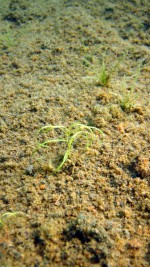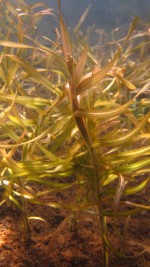Thirty years ago, researchers at the North Temperate Lakes (NTL) Long-Term Ecological Research (LTER) site began to document the exploding population of rusty crayfish in Sparking Lake in northern Wisconsin. Four years ago, they wrapped up a multi-year effort to dramatically reduce the presence of the destructive invasive species.
Now, a recent survey of the lake shows that not only have fish, insect, and plant communities bounced back in Sparkling Lake, but the invasive rusty crayfish is still on the ropes.
Gretchen Hansen, lead author of the study published in a recent issue of the Canadian Journal of Fisheries and Aquatic Sciences, says that when rusty crayfish invade a lake, they snip aquatic plants right at their roots. Scientists think this lets crayfish better spot approaching predators, but it also removes critical cover for other species, leaving them exposed to predators like smallmouth bass.
In the early 2000s, when Wisconsin researchers began the rusty removal experiment, Sparkling Lake was essentially “deforested”. There were no beds of aquatic plants, no spawning sunfish and tons of invasive crayfish. “Rusties then were crazy abundant,” Hansen recalls, adding that crayfish boils were not an uncommon occurrence for the LTER scientists and students working on the project. “We were catching 1,000 a day and eating them all the time.”
Today, they’re more likely to have a fish fry. By suppressing the rusty crayfish population, Hansen says, researchers enabled plant communities to grow back and with them the aquatic invertebrates and fish that called them home. It was an outcome researchers aspired to, but weren’t sure was possible.
Previous studies suggested that many plant species wouldn’t regrow from the lake bottom seed bank and Sparkling Lake’s fish populations were tenuous at best.
“We thought that pumpkinseeds might come back, but we were a little concerned that [bluegills] had been extirpated,” she says, noting that from 2000 to 2004, LTER sampling of Sparkling Lake turned up only a couple dozen pumkpkinseeds and no bluegills.
Today, Hansen says, rebounding populations of fish like bluegill and pumpkinseed are helping keep rusty crayfish populations down by preying on juvenile crayfish and larvae.
But the news isn’t that good for all species in the lake, she says. “Sparkling Lake used to have tons of mayfly larvae, but now you can’t find any,” Hansen says of an invertebrate species that made up a key element of the lake’s food web. “We thought they would rebound, but they haven’t.”
Hansen says this is possibly because fish like rock bass and smallmouth bass switched their diets from crayfish to aquatic invertebrates as the rusties were removed from the food web. The increase in other insect-loving fish like bluegill only made things worse for the mayflies.
“Things are often more complicated than you might expect,” she says. “But it’s a transient thing and we only know how the lake is now, four years later. That doesn’t mean that’s what it’ll be like in another four years.”
Thankfully, LTER sampling will be able to tell us exactly what Sparkling Lake is like in four years’ time. And whether mayfly populations stay repressed or rusties bounce back to dominance, or some new story emerges, LTER scientists will be out on the water watching it all go down.

 Enlarge this image
Enlarge this image


